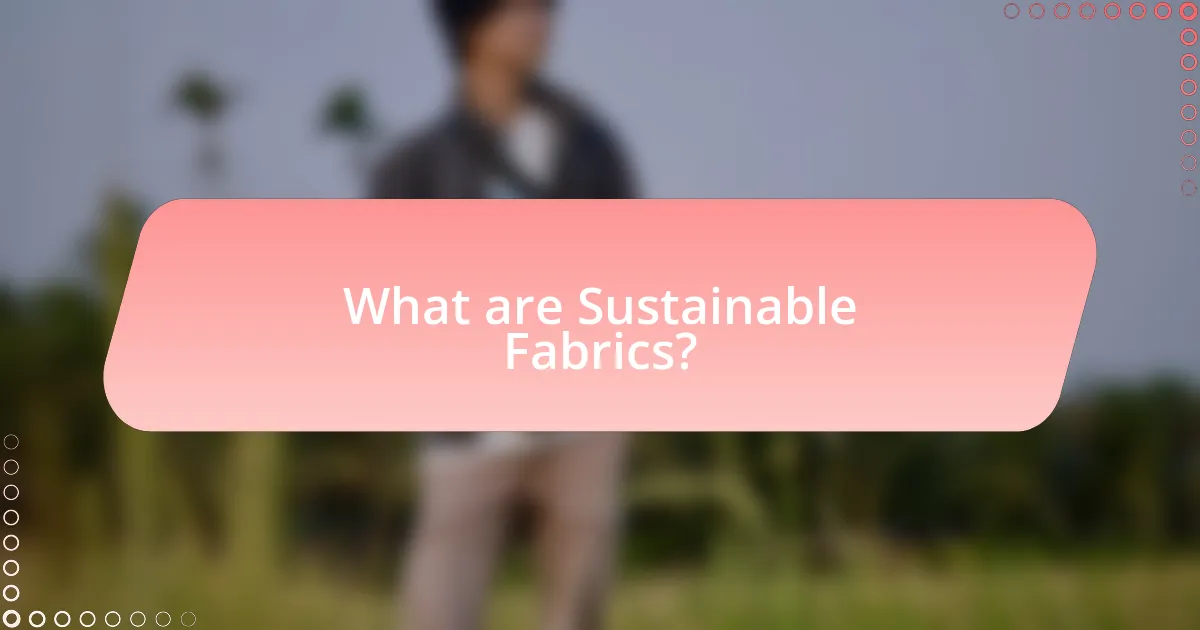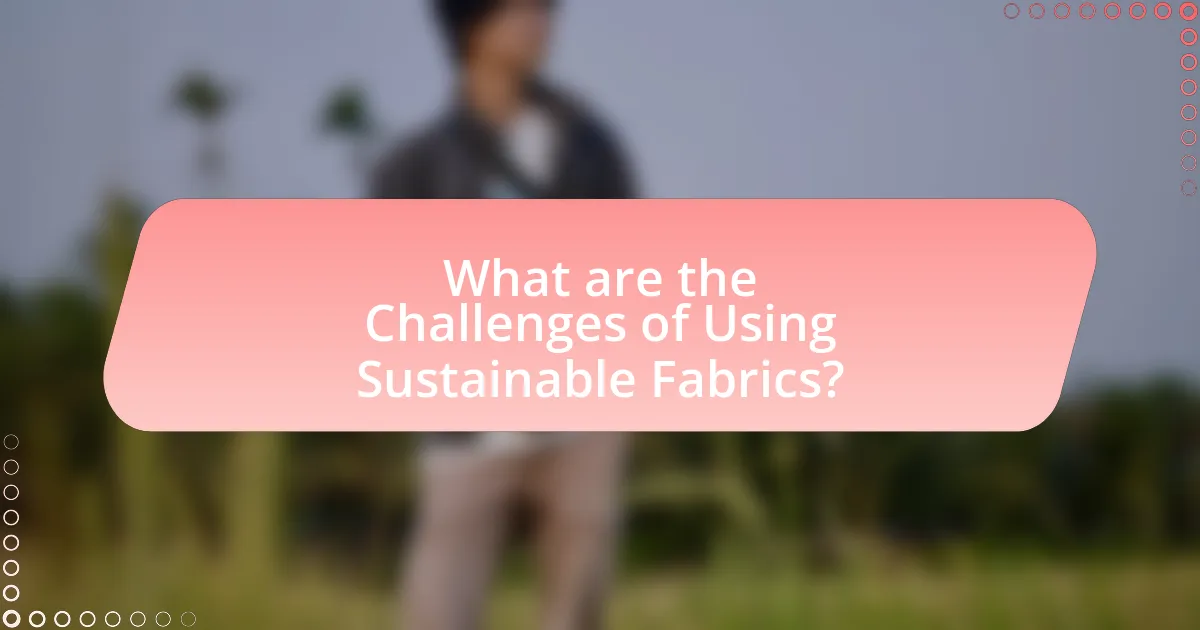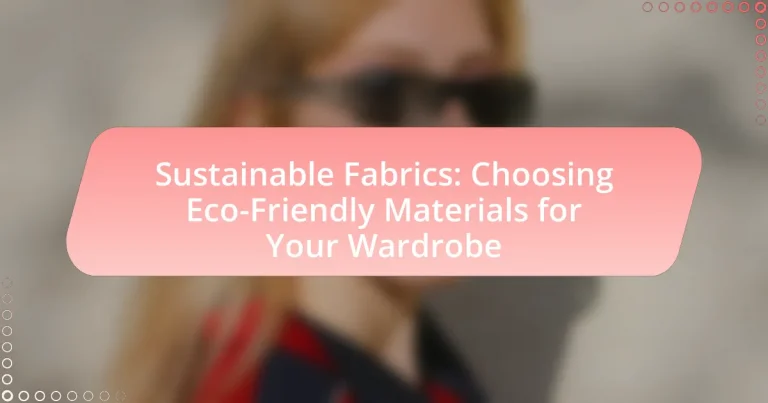Sustainable fabrics are eco-friendly materials produced with minimal environmental impact and social responsibility, often derived from renewable resources like organic cotton, hemp, and recycled materials. This article explores the importance of sustainable fabrics for environmental conservation, detailing how they reduce resource consumption, pollution, and waste. It also examines various types of sustainable fabrics, their characteristics, and how to identify and incorporate them into wardrobes. Additionally, the article addresses challenges and misconceptions surrounding sustainable fabrics, providing practical tips for consumers to support eco-friendly practices in the fashion industry.

What are Sustainable Fabrics?
Sustainable fabrics are materials produced in a way that minimizes environmental impact and promotes social responsibility. These fabrics often come from renewable resources, such as organic cotton, hemp, or recycled materials, and are manufactured using processes that reduce water usage, chemical pollution, and carbon emissions. For instance, organic cotton is grown without synthetic pesticides or fertilizers, which helps preserve soil health and biodiversity. Additionally, fabrics made from recycled plastics, like rPET, divert waste from landfills and reduce the need for virgin materials, thereby conserving resources.
Why are Sustainable Fabrics Important for the Environment?
Sustainable fabrics are important for the environment because they reduce resource consumption and minimize pollution. Traditional fabric production often involves harmful chemicals and significant water usage, contributing to environmental degradation. In contrast, sustainable fabrics, such as organic cotton or recycled polyester, utilize eco-friendly processes that lower carbon emissions and conserve water. For instance, organic cotton farming uses 91% less water than conventional cotton farming, according to the World Wildlife Fund. By choosing sustainable fabrics, consumers can help decrease waste and promote a healthier ecosystem.
How do Sustainable Fabrics reduce environmental impact?
Sustainable fabrics reduce environmental impact by utilizing eco-friendly materials and processes that minimize resource consumption and pollution. For instance, organic cotton uses 91% less water than conventional cotton and avoids harmful pesticides, which protects biodiversity and soil health. Additionally, fabrics made from recycled materials, such as polyester derived from plastic bottles, divert waste from landfills and reduce the need for virgin resources, thereby lowering carbon emissions associated with production. These practices collectively contribute to a more sustainable textile industry, promoting environmental conservation and reducing the overall ecological footprint of clothing production.
What role do Sustainable Fabrics play in reducing waste?
Sustainable fabrics play a crucial role in reducing waste by minimizing the environmental impact associated with textile production and disposal. These materials are often made from renewable resources, such as organic cotton or recycled polyester, which significantly decrease the amount of waste generated during manufacturing. For instance, using recycled polyester can divert plastic bottles from landfills, with studies indicating that recycling one ton of polyester can save approximately 6,000 pounds of carbon dioxide emissions. Additionally, sustainable fabrics are designed for durability and biodegradability, which reduces the frequency of disposal and the accumulation of textile waste in landfills. This approach not only conserves resources but also promotes a circular economy in the fashion industry.
What Types of Sustainable Fabrics are Available?
Sustainable fabrics include organic cotton, hemp, Tencel, linen, and recycled polyester. Organic cotton is grown without synthetic pesticides or fertilizers, reducing environmental impact. Hemp requires minimal water and no pesticides, making it a highly sustainable option. Tencel, made from sustainably sourced wood pulp, is produced in a closed-loop process that recycles water and solvents. Linen, derived from the flax plant, is biodegradable and requires less water than cotton. Recycled polyester, made from post-consumer plastic bottles, diverts waste from landfills and reduces reliance on virgin materials. These fabrics collectively contribute to eco-friendly fashion choices.
What are the characteristics of organic cotton?
Organic cotton is characterized by its cultivation without synthetic pesticides, herbicides, or genetically modified organisms (GMOs). This method promotes biodiversity and soil health, as organic farming practices enhance the ecosystem. Additionally, organic cotton is often produced using non-toxic dyes and sustainable water management practices, which further reduce environmental impact. According to the Global Organic Textile Standard (GOTS), organic cotton must meet strict criteria for environmental and social responsibility, ensuring that it is grown and processed in a way that is safe for both the environment and the workers involved.
How does Tencel differ from traditional fabrics?
Tencel differs from traditional fabrics primarily in its production process and environmental impact. Tencel, made from sustainably sourced wood pulp, utilizes a closed-loop process that recycles water and solvents, resulting in lower pollution and waste compared to conventional fabrics like cotton or polyester, which often require extensive water usage and chemical treatments. This eco-friendly approach is supported by the fact that Tencel fibers are biodegradable and derived from renewable resources, making them a more sustainable choice in the textile industry.
What makes hemp a sustainable choice?
Hemp is a sustainable choice due to its low environmental impact and rapid growth cycle. It requires minimal water, no pesticides, and can grow in diverse soil conditions, making it an efficient crop. Additionally, hemp absorbs more carbon dioxide per hectare than trees, contributing to carbon sequestration. According to a study by the European Industrial Hemp Association, hemp can produce up to four times more fiber per acre than cotton while using significantly less water and chemicals. This combination of factors positions hemp as an eco-friendly alternative in the textile industry.
How to Identify Sustainable Fabrics?
To identify sustainable fabrics, examine the material’s origin, production process, and certifications. Sustainable fabrics often come from organic or recycled sources, such as organic cotton, Tencel, or recycled polyester, which reduce environmental impact. Additionally, look for certifications like Global Organic Textile Standard (GOTS) or OEKO-TEX, which ensure adherence to environmental and social standards. Research indicates that organic cotton uses 91% less water than conventional cotton, highlighting the benefits of choosing sustainable materials.
What certifications should you look for in Sustainable Fabrics?
Look for certifications such as Global Organic Textile Standard (GOTS), OEKO-TEX Standard 100, and the Better Cotton Initiative (BCI) when selecting sustainable fabrics. GOTS ensures organic status and environmental and social criteria throughout the textile supply chain. OEKO-TEX Standard 100 certifies that textiles are free from harmful substances, promoting safety for consumers and the environment. BCI focuses on improving cotton farming practices, enhancing sustainability and farmer livelihoods. These certifications provide assurance of eco-friendly practices and materials in the textile industry.
How can you assess the sustainability of a fabric’s production process?
To assess the sustainability of a fabric’s production process, evaluate the environmental impact, resource usage, and social responsibility associated with its manufacturing. This includes examining factors such as the type of raw materials used, energy consumption during production, water usage, chemical treatments, and waste management practices. For instance, organic cotton, which is grown without synthetic pesticides, has a lower environmental footprint compared to conventional cotton. Additionally, certifications like Global Organic Textile Standard (GOTS) or OEKO-TEX can provide assurance of sustainable practices. Research indicates that sustainable fabrics can reduce carbon emissions by up to 30% compared to traditional materials, highlighting the importance of these assessments in making eco-friendly choices.

How to Incorporate Sustainable Fabrics into Your Wardrobe?
To incorporate sustainable fabrics into your wardrobe, start by selecting clothing made from materials such as organic cotton, Tencel, hemp, or recycled polyester. These fabrics are produced with less environmental impact compared to conventional materials, as they often require fewer chemicals and water. For instance, organic cotton uses 91% less water than traditional cotton farming, making it a more eco-friendly choice. Additionally, seek out brands that prioritize sustainability in their production processes, such as those certified by organizations like GOTS (Global Organic Textile Standard) or OEKO-TEX. By choosing these fabrics and brands, you actively contribute to reducing the fashion industry’s carbon footprint and promoting ethical practices.
What are the best practices for choosing Sustainable Fabrics when shopping?
The best practices for choosing sustainable fabrics when shopping include prioritizing materials that are organic, recycled, or produced with minimal environmental impact. Organic cotton, for example, is grown without harmful pesticides, reducing soil and water pollution. Additionally, fabrics made from recycled materials, such as recycled polyester, help divert waste from landfills and decrease the demand for virgin resources. Certifications like Global Organic Textile Standard (GOTS) and OEKO-TEX Standard 100 provide assurance that the fabrics meet specific environmental and social criteria. Furthermore, considering the lifecycle of the fabric, including its durability and biodegradability, ensures that the chosen materials contribute to a more sustainable fashion ecosystem.
How can you evaluate a brand’s commitment to sustainability?
To evaluate a brand’s commitment to sustainability, examine its transparency regarding sourcing, production practices, and environmental impact. Brands that prioritize sustainability often disclose information about their supply chain, including the use of eco-friendly materials, ethical labor practices, and carbon footprint reduction initiatives. For instance, a brand that publishes a sustainability report detailing its goals, achievements, and challenges demonstrates accountability and a genuine commitment to sustainable practices. Additionally, certifications from recognized organizations, such as Global Organic Textile Standard (GOTS) or Fair Trade, provide further validation of a brand’s sustainability efforts.
What should you consider when selecting clothing made from Sustainable Fabrics?
When selecting clothing made from sustainable fabrics, consider the material’s environmental impact, production processes, and certifications. Sustainable fabrics, such as organic cotton, Tencel, and recycled polyester, typically have a lower carbon footprint and use fewer resources compared to conventional materials. Additionally, look for certifications like Global Organic Textile Standard (GOTS) or OEKO-TEX, which ensure that the fabrics meet specific environmental and social criteria. Research indicates that organic cotton farming uses 91% less water than conventional cotton farming, highlighting the importance of material choice in sustainability.
How can you care for Sustainable Fabrics to extend their lifespan?
To care for sustainable fabrics and extend their lifespan, wash them in cold water using a gentle cycle and mild detergent. This method minimizes wear and tear while preserving the fabric’s integrity. Additionally, air drying instead of using a dryer helps prevent shrinkage and damage from high heat, which is particularly important for natural fibers like organic cotton and linen. Regularly checking for stains and treating them promptly can also prevent permanent damage, ensuring the fabric remains in good condition. Studies indicate that proper washing and drying techniques can significantly prolong the life of textiles, reducing the need for replacements and contributing to sustainability efforts.
What washing and drying methods are best for Sustainable Fabrics?
The best washing and drying methods for sustainable fabrics include using cold water, gentle cycles, and air drying. Cold water washing minimizes energy consumption and reduces the risk of damaging delicate fibers, while gentle cycles help preserve the integrity of the fabric. Air drying, as opposed to using a dryer, significantly lowers energy usage and prevents shrinkage or wear caused by high heat. These practices align with sustainability goals by extending the lifespan of garments and reducing environmental impact.
How can you repair and maintain Sustainable Fabrics effectively?
To repair and maintain sustainable fabrics effectively, use gentle cleaning methods, avoid harsh chemicals, and perform timely repairs. Gentle cleaning methods, such as hand washing or using a delicate cycle, help preserve the integrity of eco-friendly materials. Avoiding harsh chemicals, including bleach and fabric softeners, prevents damage to the fibers and maintains the fabric’s natural properties. Timely repairs, such as sewing small tears or replacing buttons, extend the life of the garment and reduce waste, aligning with sustainable practices. Regular maintenance, including proper storage and avoiding excessive washing, further enhances the longevity of sustainable fabrics.

What are the Challenges of Using Sustainable Fabrics?
The challenges of using sustainable fabrics include higher production costs, limited availability, and performance issues. Higher production costs arise because sustainable materials often require more labor-intensive processes and sourcing from specialized suppliers, which can lead to increased retail prices. Limited availability is a significant challenge, as not all sustainable fabrics are widely produced or accessible, making it difficult for manufacturers to meet consumer demand. Performance issues can also arise, as some sustainable fabrics may not offer the same durability, moisture-wicking, or stretch properties as conventional materials, potentially affecting their usability in various applications.
What are the common misconceptions about Sustainable Fabrics?
Common misconceptions about sustainable fabrics include the belief that they are always more expensive, that they lack variety, and that they are not as durable as conventional materials. Many consumers assume sustainable fabrics, such as organic cotton or Tencel, come with a higher price tag due to their eco-friendly production processes; however, prices can vary widely, and some sustainable options are competitively priced. Additionally, there is a misconception that sustainable fabrics are limited in style and color; in reality, the market offers a diverse range of designs and textures. Lastly, some people think sustainable fabrics are less durable, but studies show that many eco-friendly materials can be just as strong and long-lasting as traditional fabrics, often outperforming them in terms of wear and tear.
How do cost and availability affect the adoption of Sustainable Fabrics?
Cost and availability significantly influence the adoption of sustainable fabrics. Higher production costs associated with sustainable materials often lead to increased retail prices, making them less accessible to consumers compared to conventional fabrics. For instance, a study by the Textile Exchange found that organic cotton can be up to 20% more expensive than conventional cotton, which can deter price-sensitive buyers. Additionally, limited availability of sustainable fabrics in mainstream retail outlets restricts consumer choice, further hindering widespread adoption. According to the Global Fashion Agenda, only 1% of the global fashion market currently uses sustainable materials, highlighting the impact of both cost and availability on consumer behavior and market trends.
What are the limitations of certain Sustainable Fabrics?
Certain sustainable fabrics have limitations that include higher production costs, limited availability, and potential durability issues. For instance, organic cotton, while environmentally friendly, often requires more water than conventional cotton, leading to sustainability concerns. Additionally, fabrics like Tencel and hemp may not be as widely available as synthetic alternatives, limiting consumer choices. Furthermore, some sustainable fabrics may not withstand wear and tear as effectively as traditional materials, which can affect their longevity and practicality in everyday use. These factors highlight the complexities involved in choosing sustainable fabrics for eco-friendly wardrobes.
How can you advocate for Sustainable Fabrics in the fashion industry?
To advocate for sustainable fabrics in the fashion industry, individuals can promote awareness and education about eco-friendly materials. This can be achieved by sharing information on the environmental benefits of sustainable fabrics, such as reduced water usage and lower carbon emissions compared to conventional textiles. For instance, organic cotton uses 91% less water than conventional cotton, highlighting its sustainability. Additionally, supporting brands that prioritize sustainable practices and materials can influence consumer choices and encourage more companies to adopt eco-friendly approaches. Engaging in discussions on social media platforms and participating in community events focused on sustainability can further amplify the message and drive change within the industry.
What role do consumers play in promoting Sustainable Fabrics?
Consumers play a crucial role in promoting sustainable fabrics by driving demand for eco-friendly materials through their purchasing choices. When consumers prioritize sustainable fabrics, they encourage manufacturers to adopt environmentally responsible practices and invest in sustainable production methods. For instance, a report from the Global Fashion Agenda indicates that consumer demand for sustainable products has increased by 30% over the past five years, prompting brands to innovate and offer more sustainable options. This shift not only influences market trends but also raises awareness about the environmental impact of textile production, further motivating consumers to make informed choices that support sustainability in the fashion industry.
How can you support brands that prioritize sustainability?
You can support brands that prioritize sustainability by purchasing their products, which often utilize eco-friendly materials and ethical production practices. For instance, brands that use organic cotton or recycled polyester contribute to reducing environmental impact, as organic cotton farming uses 91% less water than conventional methods, according to the World Wildlife Fund. Additionally, you can advocate for these brands through social media, helping to raise awareness about their sustainable practices and encouraging others to make environmentally conscious choices.
What are practical tips for building a sustainable wardrobe?
To build a sustainable wardrobe, prioritize purchasing high-quality, durable clothing made from eco-friendly materials such as organic cotton, Tencel, or recycled polyester. These materials reduce environmental impact by minimizing water usage and chemical pollution during production. Additionally, consider second-hand shopping to extend the lifecycle of garments, as buying used clothing significantly decreases waste and resource consumption. Implementing a capsule wardrobe approach, which focuses on a limited number of versatile pieces, can also promote sustainability by encouraging mindful consumption and reducing impulse buying. According to a study by the Ellen MacArthur Foundation, extending the life of clothing by just nine months can reduce carbon, water, and waste footprints by around 20-30%.


